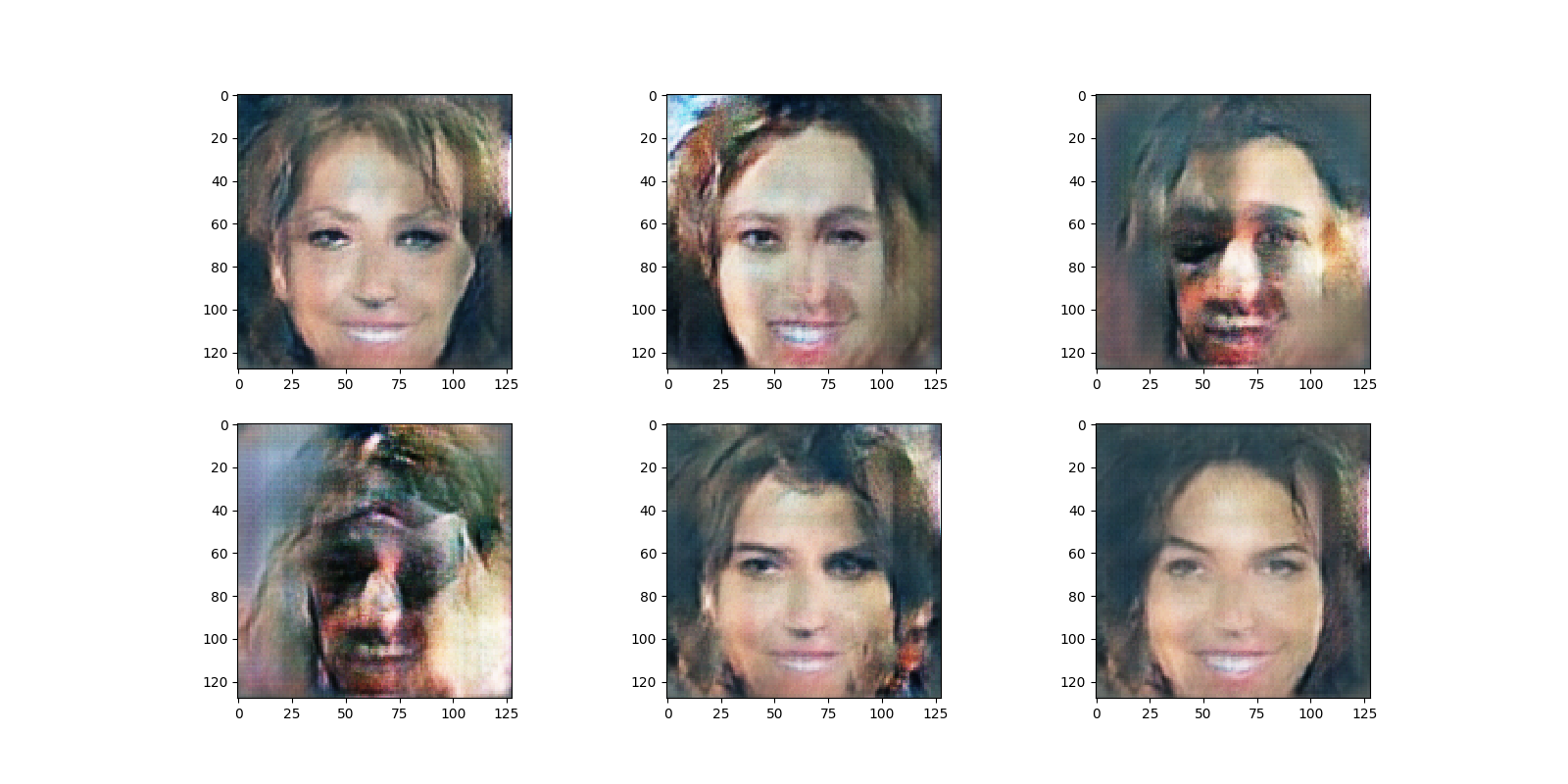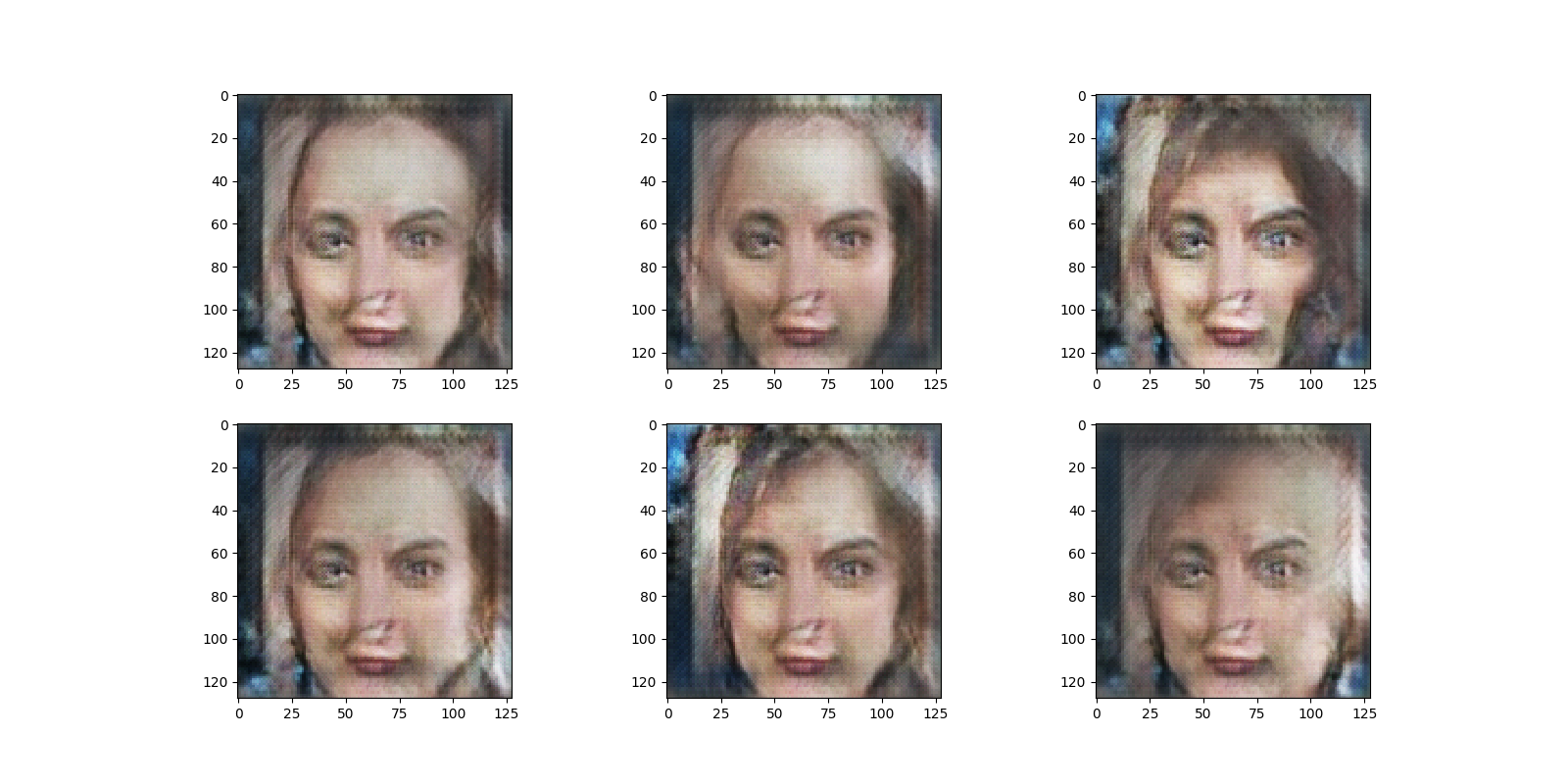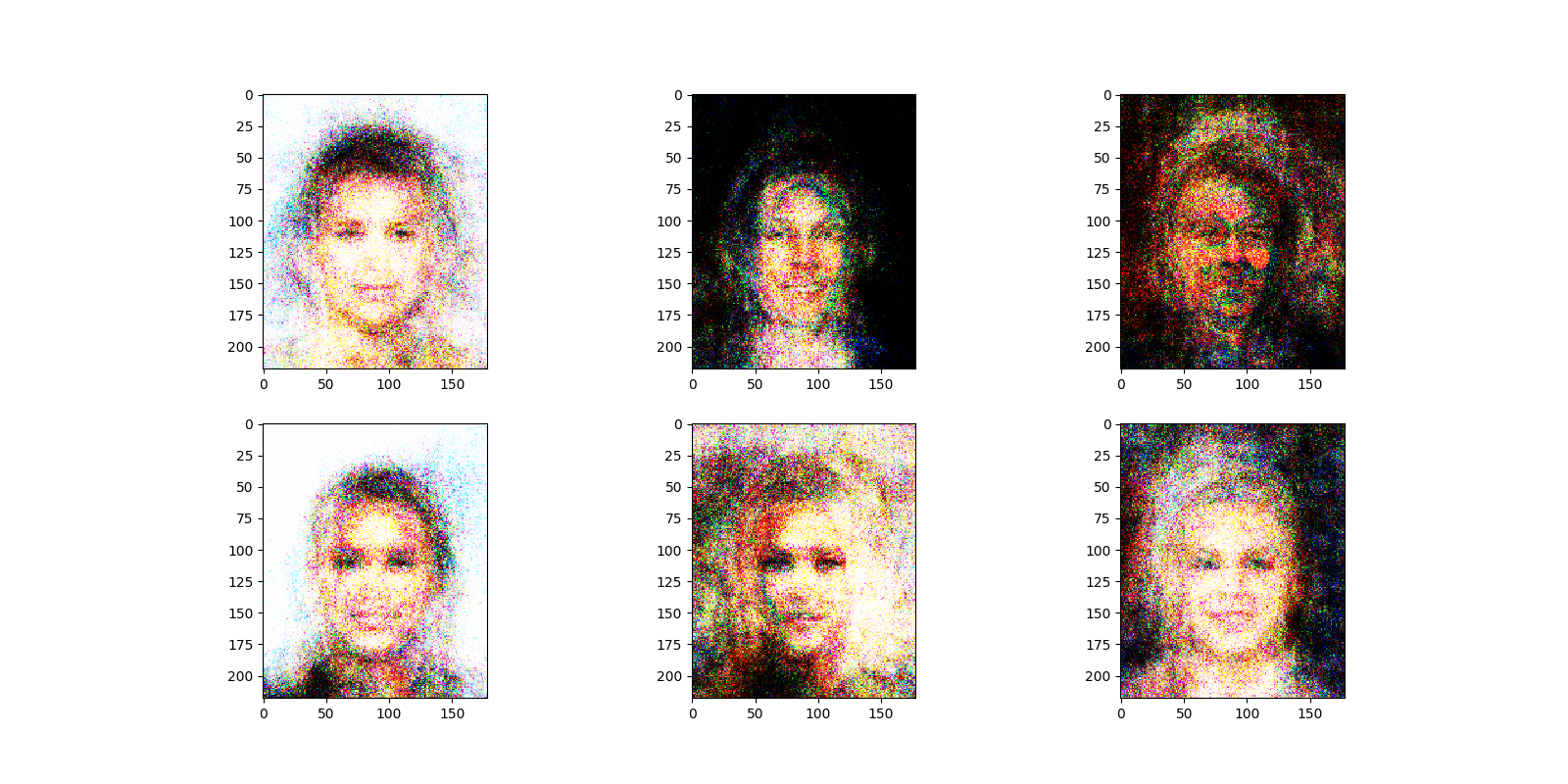卷积GAN生成人脸
数据集
- CelebA数据集:CelebA是CelebFaces Attribute的缩写,意即名人人脸属性数据集,其包含10,177个名人身份的202,599张人脸图片,每张图片都做好了特征标记,包含人脸bbox标注框、5个人脸特征点坐标以及40个属性标记,CelebA由香港中文大学开放提供,广泛用于人脸相关的计算机视觉训练任务,可用于人脸属性标识训练、人脸检测训练以及landmark标记等。
数据集处理
图片预处理:将178*218的图片裁剪为128*128的图片
def crop_centre(img, new_width, new_height): height, width, _ = img.shape startx = width // 2 - new_width // 2 starty = height // 2 - new_height // 2 return img[starty:starty + new_height, startx:startx + new_width, :]数据集处理:
class FaceDataset(Dataset): def __init__(self, file_dir): self.image_dir = file_dir # self.img_list = random.sample(os.listdir(file_dir), 10000) # 先读取文件名称,需要时再读取。 self.img_list = os.listdir(file_dir) def __len__(self): return len(self.img_list) def __getitem__(self, index): img = numpy.array(Image.open(os.path.join(self.image_dir, self.img_list[index]))) # 裁剪图片 img = crop_centre(img, 128, 128) # permute(2,0,1)将numpy数组重新排序为(3,高度,宽度)。view(1,3,128,128)为批量大小增加了一个额外的维度,设置为1。 img = torch.cuda.FloatTensor(img).permute(2, 0, 1).view(1, 3, 128, 128) return img / 255.0 def plot_image(self, index): img = numpy.array(Image.open(os.path.join(self.image_dir, self.img_list[index]))) img = crop_centre(img, 128, 128) plt.imshow(img) plt.show()
鉴别器
鉴别器设计:鉴别器使用3个卷积层和1个最后的全连接层;
代码实现:
class View(nn.Module): def __init__(self, shape): super(View, self).__init__() self.shape = shape, def forward(self, x): return x.view(*self.shape) class Discriminator(nn.Module): def __init__(self): super(Discriminator, self).__init__() self.model = nn.Sequential( nn.Conv2d(3, 256, kernel_size=8, stride=2), # (128 - 8) / 2 + 1 nn.BatchNorm2d(256), # 标准化 nn.LeakyReLU(0.2), nn.Conv2d(256, 256, kernel_size=8, stride=2), # ((61 - 8 ) / 2 + 1 nn.BatchNorm2d(256), # 标准化 nn.LeakyReLU(0.2), nn.Conv2d(256, 3, kernel_size=8, stride=2), # (27 - 8) / 2 + 1 nn.LeakyReLU(0.2), View(3 * 10 * 10), nn.Linear(3 * 10 * 10, 1), nn.Sigmoid() ) self.loss_func = nn.BCELoss() self.optimiser = torch.optim.Adam(self.parameters(), lr=0.0001) # self.optimiser.param_groups[0]['capturable'] = True # pytroch-1.12.0 的bug # 记录训练进展的计数器和列表 self.counter = 0 self.progress = [] def forward(self, inputs): return self.model(inputs) def train(self, inputs, targets): outputs = self.forward(inputs) loss = self.loss_func(outputs, targets) # 梯度归零,反向传播,并更新权重 self.optimiser.zero_grad() loss.backward() self.optimiser.step() self.counter += 1 if self.counter % 10 == 0: self.progress.append(loss.item()) def plot_progress(self): plt.scatter([i for i in range(len(self.progress))], self.progress, s=1) plt.show()
生成器
生成器设计:
生成器代码
class Generator(nn.Module): def __init__(self): super(Generator, self).__init__() self.model = nn.Sequential( # 输入是一个一维数组 nn.Linear(100, 3 * 11 * 11), nn.LeakyReLU(0.2), # 转换成四维 View((1, 3, 11, 11)), nn.ConvTranspose2d(3, 256, kernel_size=8, stride=2), # (11-1)*2-2*0+1*(8-1)+1 nn.BatchNorm2d(256), nn.LeakyReLU(0.2), nn.ConvTranspose2d(256, 256, kernel_size=8, stride=2), # (28-1)*2-2*0+1*(8-1)+1 nn.BatchNorm2d(256), nn.LeakyReLU(0.2), nn.ConvTranspose2d(256, 3, kernel_size=8, stride=2, padding=1), # (60-1)*2+2*1+1*(8-1)+1 nn.BatchNorm2d(3), nn.Sigmoid() ) # self.loss_func = nn.BCELoss() self.optimiser = torch.optim.Adam(self.parameters(), lr=0.0001) # self.optimiser.param_groups[0]['capturable'] = True # 记录训练进展的计数器和列表 self.counter = 0 self.progress = [] def forward(self, inputs): return self.model(inputs) def train(self, D: Discriminator, inputs, outputs): g_outputs = self.forward(inputs) d_outputs = D.forward(g_outputs) loss = D.loss_func(d_outputs, outputs) self.optimiser.zero_grad() loss.backward() self.optimiser.step() # 每隔10个训练样本增加一次计数器的值,并将损失值添加进列表的末尾 self.counter += 1 if self.counter % 10 == 0: self.progress.append(loss.item()) def plot_progress(self): plt.scatter([i for i in range(len(self.progress))], self.progress, s=1) plt.show()
训练GAN
- 我们向鉴别器展示一幅实际数据集中的图像,并让它对图像进行分类。输出应为1.0,我们再用损失来更新鉴别器。
- 第2步同样是训练鉴别器,不过这一次我们向它展示的是生成器的图像。输出的结果应该是0.0。我们只用损失来更新鉴别器。在这一步中,我们必须注意不要更新生成器。因为我们不希望它因为被鉴别器识破而受到奖励。
第3步是训练生成器。我们先用它生成一个图像,并将生成的图像输入给鉴别器进行分类。鉴别器的预期输出应该是1.0。我们希望生成器能成功骗过鉴别器,让它误以为图像是真实的,而不是生成的。我们只用结果的损失来更新生成器,而不更新鉴别器。
def generate_random_image(size): random_data = torch.rand(size) return random_data def generate_random_seed(size): random_data = torch.randn(size) return random_data if torch.cuda.is_available(): torch.set_default_tensor_type(torch.cuda.FloatTensor) print("using cuda:", torch.cuda.get_device_name(0)) device = torch.device("cuda" if torch.cuda.is_available() else "cpu") print(device) face_dataset = FaceDataset(r'C:\Users\ronie\Desktop\program\PyTorchLearn\dataset\face_img\img_align_celeba') D = Discriminator() D.to(device) G = Generator() G.to(device) epochs = 1 t1 = time.time() i = 0 for epoch in range(epochs): print('epoch:', epoch + 1) for image_data_tensor in face_dataset: D.train(image_data_tensor, torch.cuda.FloatTensor([1.0])) D.train(G.forward(generate_random_seed(100)).detach(), torch.cuda.FloatTensor([0.0])) # 训练生成器 G.train(D, generate_random_seed(100), torch.cuda.FloatTensor([1.0])) i += 1 if i % 100 == 0: print(i) if i % 10000 == 0: torch.save(D, os.path.join(r'C:\Users\ronie\Desktop\program\PyTorchLearn\pth\gan_face', 'Dface_cnn_with_{}pictures.pth'.format(i + 400000))) torch.save(G, os.path.join(r'C:\Users\ronie\Desktop\program\PyTorchLearn\pth\gan_face', 'Gface_cnn_with_{}pictures.pth'.format(i + 400000))) print((time.time() - t1) / 60) G.plot_progress() D.plot_progress()
训练结果
查看训练
for i in range(1, 2): G = torch.load( r'C:\Users\ronie\Desktop\program\PyTorchLearn\pth\gan_face\Gface_cnn_with_{}0000pictures.pth'.format(45)) # 在3列2行的网格中生成图像 f, axarr = plt.subplots(2, 3, figsize=(16, 8)) for i in range(2): for j in range(3): output = G.forward(generate_random_seed(100)) imgs = output.detach().permute(0, 2, 3, 1).view(128, 128, 3).cpu().numpy() axarr[i, j].imshow(imgs, interpolation='none', cmap='Blues') plt.show()训练结果图片
- 长的有鼻子有眼儿的








2025年10月新盘 做第一批吃螃蟹的人coinsrore.com
新车新盘 嘎嘎稳 嘎嘎靠谱coinsrore.com
新车首发,新的一年,只带想赚米的人coinsrore.com
新盘 上车集合 留下 我要发发 立马进裙coinsrore.com
做了几十年的项目 我总结了最好的一个盘(纯干货)coinsrore.com
新车上路,只带前10个人coinsrore.com
新盘首开 新盘首开 征召客户!!!coinsrore.com
新项目准备上线,寻找志同道合 的合作伙伴coinsrore.com
新车即将上线 真正的项目,期待你的参与coinsrore.com
新盘新项目,不再等待,现在就是最佳上车机会!coinsrore.com
新盘新盘 这个月刚上新盘 新车第一个吃螃蟹!coinsrore.com
2025年10月新盘 做第一批吃螃蟹的人coinsrore.com
新车新盘 嘎嘎稳 嘎嘎靠谱coinsrore.com
新车首发,新的一年,只带想赚米的人coinsrore.com
新盘 上车集合 留下 我要发发 立马进裙coinsrore.com
做了几十年的项目 我总结了最好的一个盘(纯干货)coinsrore.com
新车上路,只带前10个人coinsrore.com
新盘首开 新盘首开 征召客户!!!coinsrore.com
新项目准备上线,寻找志同道合 的合作伙伴coinsrore.com
新车即将上线 真正的项目,期待你的参与coinsrore.com
新盘新项目,不再等待,现在就是最佳上车机会!coinsrore.com
新盘新盘 这个月刚上新盘 新车第一个吃螃蟹!coinsrore.com
新车新盘 嘎嘎稳 嘎嘎靠谱